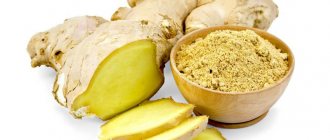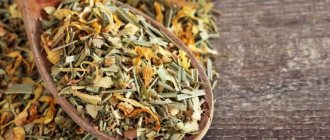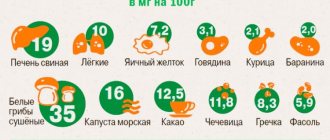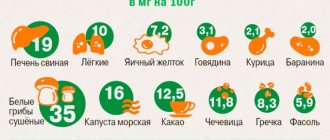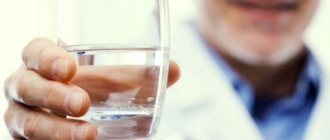Products that reduce blood pressure
Hypertension is a systemic increase in blood pressure greater than 140/110 mm Hg.
Art. This disease requires not only constant use of medications, but also lifestyle adjustments. Diet for hypertension is very important. It will help lower blood pressure and control your health. The diet of a hypertensive patient should be filled with foods that contain a lot of plant-type fiber. It should be consumed by all people, as it contains many vitamins and minerals. The factor that increases blood pressure is atherosclerosis. Therefore, products with a high content of lipotropic substances are additionally important. They contribute to the removal of cholesterol, which forms atherosclerotic plaques, and its breakdown.
Foods that lower blood pressure must contain protein, but in adequate quantities. Only in this case does it contribute to normal vascular tone, and even normalization of the functioning of the nervous system, which allows the body to be more resistant to psycho-emotional shocks. And this is the prevention of high blood pressure.
Also, hypertensive patients need to eat foods that contain magnesium, calcium, and potassium in order to increase their amount in the body. They improve the functioning of the heart and blood vessels. Calcium is absorbed only if it enters the body along with protein. That is why it is recommended to consume more dairy and fermented milk products.
Other foods that lower blood pressure are those that contain polyunsaturated fatty acids. They are found at the highest level in fish and other seafood.
These fatty acids help reduce the absorption of animal fats and reduce cholesterol, which means they are needed to lower blood pressure. A strict diet for hypertension is contraindicated, as it can be harmful to health. This disease requires a balanced, healthy diet. Therefore, it is impossible to lose weight with the help of special limited diets, not to mention fasting. With high blood pressure, you need to constantly replenish your reserves of nutrients.
Necessary products for hypertension:
- Lean meats - veal, beef, chicken, turkey. Poultry meat should be consumed without skin.
- Soups with vegetable broth, dairy first courses are also useful.
- Various seafood. Shrimp, squid, and seaweed are especially useful.
- Dairy and fermented milk products. It is better that they have a low fat content - cottage cheese, kefir, yogurt. You should also drink skim milk. It is recommended to eat sour cream only as part of other dishes. Hard cheese should be unsalted and low-fat; other varieties should not be eaten if you have high blood pressure.
- You should consume no more than 20 g of butter; it is recommended to add it to dishes.
- You should eat a lot of greens, as they contain vitamins necessary for vascular tone (C, group B).
- Fresh vegetables. It is very important for hypertensive patients to eat zucchini, Jerusalem artichoke, and pumpkin, as they contain substances that remove cholesterol. You should also eat other vegetables in the form of salads dressed with vegetable oil. In the case of diseases of the cardiovascular system, it is necessary to consume green peas and legumes, as they contain a lot of magnesium.
- Potatoes are best eaten baked.
- Sour berries and fruits, as they contain pectin. It is recommended to eat more gooseberries, apples, plums, figs, and dates.
- Dried fruits are all very healthy.
- Eggs can be eaten boiled or as an egg white omelet. It is recommended to use them about 4 times a week.
Among the sweets, mousses made from berries and fruits, as well as jelly and homemade marmalade will be useful. Honey and jam should be eaten in limited quantities.
The question “what foods reduce blood pressure” is often asked by therapists. They, in turn, provide not only a detailed list of dishes, but also advise what seasonings can be used to diversify the menu. These may include bay leaf, dried parsley and dill, cumin, vanillin, cinnamon and citric acid. Nutrition for hypertension should be comprehensive. For drinks, you can drink tea with lemon and milk, but the brew should not be very rich; coffee lovers can drink chicory or barley drink. It is also very useful to drink compotes and decoctions.
Carnation
This seasoning has a very distinctive bright and strong aroma that can overshadow other spices in a dish. Cloves are added to soups, decoctions, as well as juices and compotes. It is also a seasoning that can be safely used for medicinal purposes. Regular chewing of these little flower buds will not only help freshen your breath and keep your mouth healthy, but also help in the fight against high blood pressure.
Diet principles
It should be noted that the diet for hypertensive patients is the same for both women and men. Proper nutrition for high blood pressure is the key to health for all people.
In order for your diet to help lower blood pressure, you need to adhere to the basic principles of the diet:
- Meat is available in limited quantities. It’s good if a person eats meat 2-3 times a week.
- You can eat only one yolk per day, but at the same time you can eat about 2-3 egg whites.
- It is necessary to minimize the consumption of sugar, since it is a refined carbohydrate, which can increase blood pressure levels.
- It is advisable that vegetables be present in the diet daily, in an amount of about 400 g.
Nutrition for arterial hypertension should occur on a fractional basis. You need to eat food 5-6 times a day, but in smaller portions than usual. This allows you to reduce the load on the body, in particular on the cardiovascular system. If you adhere to this diet, a person will not gain excess weight, since obese people often have a history of arterial hypertension. Another important aspect of the diet is that dinner should take place no later than 3 hours before bedtime.
For hypertension, it is important not only which foods lower blood pressure, but also how to prepare them. You can use all methods except frying. Boiled, steamed and baked foods are allowed. It is not recommended to frequently eat dishes prepared by stewing.
For arterial hypertension, the diet excludes fried foods, since during the frying process fats release breakdown products. It is these substances that are very harmful to blood vessels, they can even provoke the manifestation of malignant neoplasms.
Salt is a spice that negatively affects blood vessels, and its amount is greatly reduced during a diet for hypertension. It is recommended to consume up to 5 g of salt per day. It is this that causes vasospasm, increases blood volume, and this leads to increased blood pressure. Salt retains fluid in the body.
A cholesterol-lowering diet for patients with hypertension should include the consumption of certain fats. In this case, it’s not even so important how many people consume them, the main question is what kind of fats they are.
All trans fats are strictly excluded from the diet of patients with hypertension. They are found in different foods:
- sausage and frankfurters;
- meat;
- hard cheese;
- ice cream.
Products that lower blood pressure in this case are: fish, olive oil, you can take fish oil separately. The fats contained in these products are very healthy.
Nutrition for high blood pressure should consist of foods that are rich in vitamins and microelements:
- Vitamin C helps strengthen the walls of blood vessels and also has anti-atherosclerotic properties. It should also be noted that it helps strengthen the body's defenses.
- B vitamins also act on vascular walls, relieving their spasm, and protect blood vessels from the formation of atherosclerosis plaques in them.
- Iodine is important for hypertension; the diet for hypertension should include foods high in iodine, as it prevents the progression of atherosclerosis.
- Phosphorus improves the functioning of brain vessels.
- Calcium is able to exert its effect on blood vessels, maintaining them in normal tone.
- Potassium is very important in hypertension because it has a vasomotor effect and is a sodium antagonist.
Potassium is a special microelement for arterial hypertension. Sometimes nutritionists recommend doing potassium fasting days. But it is important that the diet plan for that day is prescribed by a doctor, depending on the degree of pathology. With hypertension and diabetes, it is important to take into account the amount of potassium entering the body and insulin in the blood. If there are no simple carbohydrates in the body, insulin levels will decrease.
Garlic
From time immemorial, garlic has been considered a natural antibiotic and also helps normalize blood pressure. It has been proven that people who regularly consume garlic in large quantities have lower systolic blood pressure. Garlic can be added to a variety of dishes - meat, vegetables, sauces, and fish. Don't delay, buy fresh garlic today.
Table No. 10
There is a special diet for hypertension and atherosclerosis - table No. 10. Its main criteria are avoidance of salt consumption, and you should also drink no more than 1.2 liters of liquid per day. Another mandatory measure of the tenth diet is reducing the calorie content of food. For hypertension, eating according to these rules will help saturate the body with essential microelements. These substances help normalize fat metabolism, so that they are not deposited in the liver and blood vessels.
That is why diet therapy involves eating foods that are quickly digested and prepared only by baking, boiling or steaming. Proper nutrition for hypertension should contain a certain amount of calories. The calorie content of food eaten should not exceed 2500 kcal. in a day. It is better to cancel salt or reduce it to 4 g per day.
The exact scheme of the daily menu should include about 70 g of fat (20% of which comes from vegetable fats), carbohydrates should be about 400 g, and proteins should be 90 g (no more than 50% of which should be of animal origin). For hypertension, a diet according to these rules is necessary, as it will prevent the development of atherosclerosis.
It should be noted that you should not eat if you have hypertension:
- Fresh baked goods. A diet for arterial hypertension involves eating stale, slightly dried bread, which is made from flour with bran.
- Baked goods and puff pastry are prohibited, as these products contain sugar and margarine, which are contraindicated for hypertension and atherosclerosis.
- Duck and goose meat, offal.
- Fatty dairy products, salty cheese.
Added to the list of what you cannot eat are sauerkraut, salted and pickled vegetables, raw onions and garlic, radishes, mushrooms, spinach, and sorrel. You can't eat lard either.
The high blood pressure diet suggests that the meat should first be boiled in one water, which should be drained after the meat has boiled. Next, it is boiled in new water, and only after that the dish can be eaten. Meats allowed include turkey, chicken, veal, beef, and rabbit.
Diet for arterial hypertension No. 10 allows pasta from durum wheat and cereals. Only their preparation must be correct - cook with water or milk, without adding salt and sugar. This diet for stage 2 hypertension is also effective, and medical practice proves this.
Basil against constriction of blood vessels
For centuries, traditional Chinese medicine has recommended basil to treat heart disease. Also, its use for medicinal purposes has a scientific basis. Research has shown that basil reduces the levels of substances such as endothelin-1 and angiotensin-II, which, at high concentrations, cause significant constriction of blood vessels.
Basil has a special place in Italian cuisine and goes well with dishes containing tomatoes. Add it to marinades and pasta sauces. Basil is an integral component of pesto sauce.
Sample menu
This menu can be prescribed by a doctor and adjusted at his discretion for a more effective fight against hypertension.
Monday
Breakfast: 200 g of steamed oatmeal, 100 g of assorted dried fruits (figs, dates, dried apricots, prunes).
Lunch: 150 g of fruit mousse (banana, apple, persimmon).
Lunch: 150 g whole grain pasta, 80 g goulash, 70 g broccoli salad.
Afternoon snack: 200 g of berry-curd dessert (fresh).
Dinner: 200 g fish meatballs, 30 ml sour cream,
2 hours before bedtime: 250 ml of 1% kefir.
Tuesday
Breakfast: 200 g of rice and fruit porridge (raisins, banana, dates), 70 g of rye bread (dried), 20 ml of honey.
Lunch: 150 g of berry-nut mixture (grapes, cranberries, blackberries, almonds, hazelnuts).
Lunch: 200 ml fish soup, 150 g beetroot-prune salad, 10 g garlic.
Afternoon snack: 150 g potatoes (baked or boiled), 100 g tomatoes, 20 ml camelina oil.
Dinner: 200 g buckwheat, 100 g sauerkraut, 70 g boiled turkey.
2 hours before bedtime: 250 ml of green cocktail (kefir, herbs, honey, banana).
Wednesday
Breakfast: 200 ml of chicory drink, 100 g of cranberry jam (ground with sugar), 70 g of whole grain bread (dried), 50 g of walnuts.
Lunch: 200 g curd soufflé, 50 g raisins.
Lunch: 250 g lentil soup, 100 g chopped vegetables, 15 ml flax seed oil.
Afternoon snack: 150 ml yogurt, 100 g fresh fruit (strawberries, banana, apples).
Dinner: 200 g chicken breast with vegetables (stewed), 100 g beet-garlic salad, 40 g celery leaves.
2 hours before bedtime: 200 ml of homemade serum.
Thursday
Breakfast: 150 g apple pudding with raisins, 150 ml rosehip broth, 30 ml flower honey.
Lunch: 150 g berry compote, 100 g cottage cheese casserole.
Lunch: 200 g borscht with beans, 100 g rice meatballs, 50 g vegetable mixture (tomato, cucumber, celery).
Afternoon snack: 150 g seaweed salad, 20 ml cedar oil
Dinner: 150 g mashed potatoes, 100 g zucchini-eggplant caviar, 70 g chicken cutlets (steamed).
2 hours before bedtime: 150 ml of yogurt.
Friday
Breakfast: 150 g egg omelet, 100 g sauerkraut, 70 g bacon.
Lunch: 200 ml hibiscus tea, 100 g oatmeal cookies.
Lunch: 200 g pilaf, 100 g beetroot-garlic salad, 20 ml flax seed oil.
Afternoon snack: 200 g of fruit and berry jelly.
Dinner: 250 g vegetable stew, 50 g boiled veal.
2 hours before bedtime: 250 ml of yogurt.
Saturday
Breakfast: 200 g of oatmeal, 100 g of fermented baked milk, 70 g of dried fruits (unabi, dates, raisins, prunes), 50 g of biscuits.
Lunch: 200 ml cinnamon milkshake.
Lunch: 200 g squash-eggplant caviar, 100 g bean puree, 50 g leafy greens.
Afternoon snack: 200 ml yogurt, 50 g walnuts.
Dinner: 250 g of green buckwheat, 150 g of boiled vegetables (eggplant, beets, zucchini, carrots), 70 g of chicken steak (baked).
2 hours before bedtime: 200 ml of serum.
Sunday
Breakfast: 200 ml cocoa, 70 g bran bread, 50 g cheese, 30 g butter.
Lunch: 200 g seasonal berries, 50 g almonds.
Lunch: 150 g jacket potatoes, 100 g cauliflower in batter, 100 g baked turkey, 15 ml camelina oil.
Afternoon snack: 200 ml mint tea, 150 g oatmeal-curd casserole.
Dinner: 150 g fish steak (stewed), 100 g vegetable mixture (tomatoes, celery, peppers, cucumbers, garlic).
2 hours before bedtime: 200 ml of kefir.
Spices and seasonings
Ginger has blood pressure-normalizing properties. Although formally it cannot be attributed to this group. This is a full-fledged independent product.
- The substances based on it thin the blood, acting as a natural antiplatelet agent.
- In addition, they help relax the vascular muscles, preventing further spasm and an increase in tonometer readings.
Turmeric is called a good help in prevention and even therapy. The substance of the same name in its composition helps to quickly reduce blood pressure, but gently, and therefore does not create health risks.
Hot cayenne pepper. He's chili. The product is used to rapidly reduce blood pressure. This is a reflex response to the use of capsaicin, which the product is so rich in.
But this can be dangerous, since a sharp jump in blood pressure does not affect the condition of the blood vessels (their elasticity). Pepper is allowed for hypertensive patients, but it should be eaten with caution.

